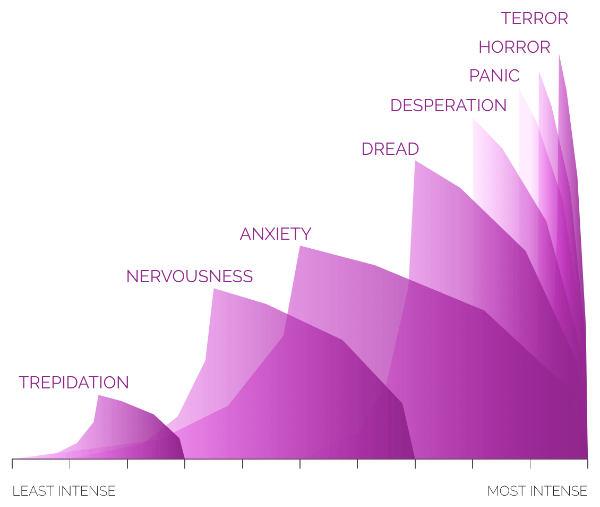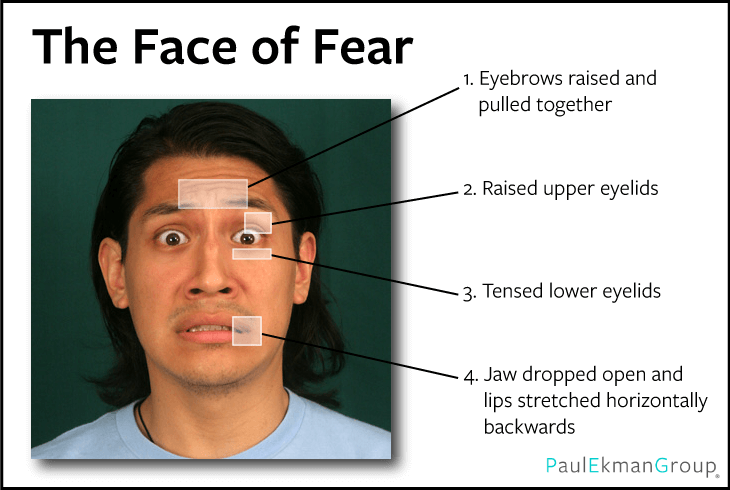Source: Atlas of Emotions
In my dictionary of Feelings and Needs, Afraid is defined as “a feeling of fear, dread, or apprehension in response to a perceived threat or impending danger.”
The following are listed as synonyms: Fearful, Apprehensive, Scared, Terrified
In this post, renown emotions expert Dr Paul Ekman provides further guidance on fear:
What is Fear?
Fear is one of the seven universal emotions experienced by everyone around the world. Fear arises with the threat of harm, either physical, emotional, or psychological, real or imagined. While traditionally considered a “negative” emotion, fear actually serves an important role in keeping us safe as it mobilizes us to cope with potential danger.
Feeling fear
The family of fearful experiences can be distinguished in terms of three factors:
Intensity: How severe is the harm that is threatened?
Timing: Is the harm immediate or impending?
Coping: What, if any, actions can be taken to reduce or eliminate the threat?
When we are able to cope with the threat, this lessens or removes the fear. Alternatively, when we are helpless to decrease the threat of harm, this intensifies the fear.
Fear can sometimes take place immediately following surprise and often oscillates with the experience of anger.
What makes us fearful
The universal trigger for fear is the threat of harm, real or imagined. This threat can be for our physical, emotional or psychological well-being. While there are certain things that trigger fear in most of us, we can learn to become afraid of nearly anything.
Common fear triggers:
Darkness or loss of visibility of surroundings
Heights and flying
Social interaction and/or rejection
Snakes, rodents, spiders and other animals
Death and dying
Moods and disorders
Persistent fear can sometimes be referred to as anxiety if we feel constantly worried without knowing why. The inability to identify the trigger prevents us from being able to remove ourselves, or the actual threat, from the situation.
While anxiety is a common experience for many people, it can be considered a disorder when it is recurrent, persistent, intense, and interferes with basic life tasks such as work and sleep.
Recognizing fear
The facial expression of fear is often confused with surprise. While both expressions show distinctly raised eyebrows, a fear expression's eyebrows are straighter and more horizontal whereas in surprise they are raised and curved. The upper eyelid is also lifted higher in fear than in surprise, exposing more sclera (white of the eye). Finally, the lips are tensed and stretched in fear but more open and slack in surprise.
Source: The Paul Ekman Group
Vocal expression of fear
When experiencing fear, one’s voice often has a higher pitch and more strained tone. One may also scream.
Sensations of fear
Common sensations include feeling cold and shortness of breath. It also may include sweating and trembling or tightening of muscles in the arms and legs.
Posture of fear
The posture of fear can either be one of mobilizing or immobilizing- freezing or moving away.
The function of fear
The universal function of fear is to avoid or reduce harm. Depending on what we have learned in the past about what can protect us in dangerous situations, we are capable of doing many things we wouldn’t typically be able, or willing, to do in order to stop the threat.
The immediate threat of harm focuses our attention, mobilizing us to cope with the danger. In this way, fear can actually save our lives by forcing us to react without having to think about it (e.g., jumping out of the way of a car coming at us). The evolutionary preset actions of fear include fight, flight and freezing.
Responding to fear in ourselves
While traditionally considered a “negative” emotion, fear actually serves an important role in keeping us safe. It can, however, also keep us feeling trapped and prevent us from doing things we’d like to. Whereas some people find fear nearly intolerable and avoid the emotion at all costs, others experience pleasure from feeling fear and seek it out (i.e., watching a horror film).
Responding to fear in others
It takes a well-developed capacity for compassion to respect, feel sympathetic toward, and patiently reassure someone who is afraid of something we are not afraid of (most of us dismiss such fears). We do not need to feel another person's fear to accept it and help them cope.
Paul Ekman is a well-known psychologist and co-discoverer of micro expressions. He was named one of the 100 most influential people in the world by TIME magazine in 2009. He has worked with many government agencies, domestic and abroad. Dr. Ekman has compiled over 50 years of his research to create comprehensive training tools to read the hidden emotions of those around you. You can read this article on his website here.

